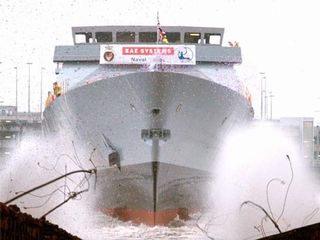The technology behind HMS Daring
The Navy's most advanced ship under the tech microscope

HMS Daring, the Royal Navy's new super-advanced Type 45 Destroyer, sailed into its home port of Portsmouth for the first time today.
The first of six Type 45 Destroyers – originally there were meant to be 12 but this has since been trimmed down – HMS Daring is packed to the rafters with technology which will significantly aide the vessel in its main mission, which is to: "provide local area fleet defence, with long-range radar and wide area defence capability."
Size matters
The Type 45 vessels have been built as a direct replacement for the Navy's Type 42 ships, which are now more than 30 years old.
The immediate difference is size. The new destroyers weigh in over 7,000 tonnes, are 152.4 metres in length – more than 50 per cent bigger than their predecessors – and have a maximum speed of 27kt.
The destroyers have a range of around 7,000nm and can carry a crew of 190 people comfortably – 235 at a squeeze. Oh, and there's also space for a Royal Navy Merlin helicopter.
Bringing out the big guns
Get daily insight, inspiration and deals in your inbox
Get the hottest deals available in your inbox plus news, reviews, opinion, analysis and more from the TechRadar team.
HMS Daring's main weapon of choice is a missile silo capable of holding 48 anti-aircraft missiles. Called the PAAMS (Principal Anti Air Missile System) the system will be packed with cruise missiles, like the Tomahawk, and has a 360 degree firing range.
These missiles have been dubbed super-agile, come with a re-attack mode and will have a range of between 30 and 80kms, with speeds reaching Mach 4.
Secondary weaponry includes a 114mm mk8 medium-calibre gun system for shore bombardment and two 30mm guns.
To make sure the guns are as accurate as possible, BAE Systems, teamed with Radamec Defence Systems, have created an electro-optical gunfire control system (EOGCS).
Energy efficient
To make sure that no power is going to waste, HMS Daring has been equipped with by two WR-21 advanced cycle gas turbine engines which come complete with some nifty cooling tech – real name: intercooler and recuperator (ICR) heat exchangers – which help save fuel and increase fuel efficiency.
This is a good thing as each of the massive engines will provide the ship with 25MW of power.
Not that this means that the ship is any way noisy. The engines are made in such a way that they are high on performance but low on signature sound, so detection by enemy submarines shouldn't be too much of a problem.
On the (tech)radar
Radar technology has been vastly improved with the destroyers sporting a Sampson wide-area, long-range search radar which will handily let the captain know of any impending torpedo attacks and offering sage advice on how to avoid being bombed.
PAAMS, the ship's missile system, uses radar technology, too. The missiles are guided by the Sampson phased-array radar system, situated on top of the ship's main mast.
The radar is so good that it can reportedly detect a threat the size of cricket ball coming at three times the speed of sound. So any enemy thinking of employing Shane Warne as a weapon better watch out.
The power of six
HMS Daring is part of a six-ship fleet which will be fully operational, according to the Ministry of Defence by 2014.
The other ships in the fleet are named as: HMS Dauntless, HMS Diamond, HMS Dragon, HMS Defender and HMS Duncan.
Dauntless and Duncan are set for commission 2010 and 2011 respectively, with the rest of the ships to follow soon after. Each ship has cost a reported £1 billion to make.
Marc Chacksfield is the Editor In Chief, Shortlist.com at DC Thomson. He started out life as a movie writer for numerous (now defunct) magazines and soon found himself online - editing a gaggle of gadget sites, including TechRadar, Digital Camera World and Tom's Guide UK. At Shortlist you'll find him mostly writing about movies and tech, so no change there then.
Most Popular


